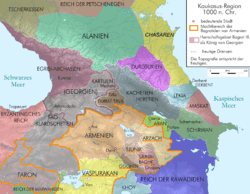Kingdom of Artsakh
The Kingdom of Artsakh (Armenian: Արցախի թագավորություն) was a medieval dependent Armenian kingdom on the territory of Syunik, Artsakh (present-day Nagorno-Karabakh), Gardman and Gegharkunik.[1] Contemporary sources referred to it as the Khachen. The royal house of Khachen was a cadet branch of the ancient Syunid dynasty and was named Khachen, after its main stronghold. The kingdom emerged when Hovhannes-Senekerim acquired the royal title in 1000.
Kingdom of Artsakh | |||||||||
|---|---|---|---|---|---|---|---|---|---|
| 1000–1261 | |||||||||
 Royal Standard of the Principality of Khachen (Kingdom of Syunik) during the reign of Grand Prince Hasan Jalal Vahtangian (1214-1261) | |||||||||
 Syunik as vassal of the Armenian kingdom around 1000 | |||||||||
| Capital | Khachen, Haterk, Vaykunik | ||||||||
| Common languages | Armenian | ||||||||
| Religion | Armenian Apostolic | ||||||||
| Government | Monarchy | ||||||||
| King | |||||||||
| History | |||||||||
• Established | 1000 | ||||||||
• Subdivision of the kingdom | 1182 | ||||||||
• Acquisition of Dizak and Gardman | 1261 | ||||||||
• Assassination of Hasan Jalal, last king of Syunik | 1261 | ||||||||
| |||||||||
The kingdom was under the protectorate of the Bagratuni kings of Armenia.
Artsakh maintained its sovereign rulers, though in the early 13th century they accepted Georgian, then Mongol suzerainty.[2] They lost the royal title after the assassination of Hasan-Jalal (1214–1261) by the Ilkhanid ruler Arghun, but continued to rule Syunik as a principality, which from the 16th century comprised five Armenian melikdoms of Artsakh and Kashatagh melikdom of Syunik which lasted until the early 19th century.[1] The descendants of the kings of Syunik played a prominent role in the history of Syunik as far as the 20th century.
References
- Hewsen, Robert H (2001). Armenia: A Historical Atlas. Chicago: University of Chicago Press. pp. 118–121. ISBN 0-226-33228-4.
- Hewsen, Robert H. "The Meliks of Eastern Armenia: A Preliminary Study." Revue des Études Arméniennes. NS: IX, 1972, pp. 255-329.
Further reading
- Robert H. Hewsen. "The Kingdom of Arc'ax" in Medieval Armenian Culture (University of Pennsylvania Armenian Texts and Studies). Thomas J. Samuelian and Michael E. Stone (eds.) Chico, California: Scholars Press, 1984. ISBN 0-89130-642-0.

